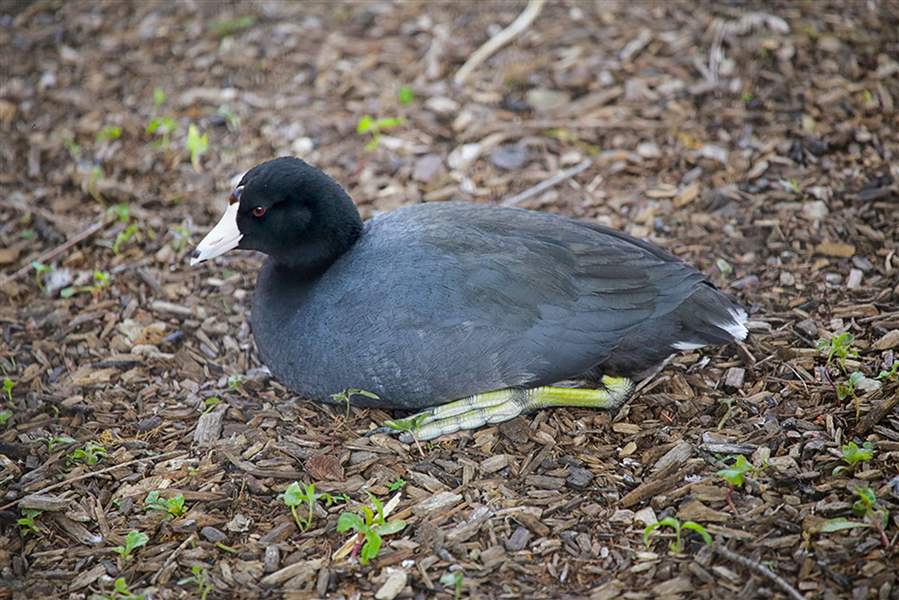
Fowl ball: Toledo Zoo acquires real-life mud hen
4/21/2018
Remarkably, the Toledo Zoo didn't have a mud hen on display, so a local resident stepped in and donated one.

Like the ballplayers, the coots generally arrive here just in time for spring, then head to warmer climes for winter.
Your in-laws? Be nice. We’re talking the mud hens.
You know, the American coots — the migratory marsh birds also known as the namesake of our local nine.
Well, we recently heard the city had its first known year-round hen resident, and had to know the story.
And see the little guy.
Toledo Mud Hens, meet the Toledo mud hen.
WATCH: Toledo Zoo bird curator talks about the mud hen
The other day at the Toledo Zoo, there she was, slate-gray body and white bill, happily swimming in a pond filled with ducks, which would have been perfect, except this bird only hits fowl balls (Sorry!).
Still, don’t let that fool you. Despite weighing only 1½ pounds, she’s just the kind of scrappy, get-your-feathers-dirty-type any good team needs, tough as any of her first-place human kin at Fifth Third Field.
Think Christin Stewart’s home run to the moon last week was impressive?
The Toledo mud hen fought off a bald eagle and lived to cluck about it.
Yes, while residing in a Wisconsin marsh in 2013, she was attacked by a swooping eagle in search of supper. She sustained lacerations that resulted in her left wing being amputated, but ...
“You should see the shape the eagle is in,” cracked Chuck Cerbini, the Toledo Zoo’s curator of birds.
WATCH: Mud hen gets comfortable in its new home at the Toledo Zoo
Now, a little background.
After a rehab assignment, the hen was acquired before last season from the Columbus Zoo as the centerpiece of a trade package that included a robin and rumored cardinal to be named later, the result of a years-long mission by a baseball-loving local executive.
For years, Gary Marck wondered how it was that our great zoo did not have a mud hen.
Strange, right? Because there’s nothing more Toledo than the Mud Hens. In fact, next to the Durham Bulls, the Hens have to be the most well-known minor league brand, their perfectly peculiar name and mascot burrowed not only into our civic fabric but pop culture. Toledo native Jamie Farr’s Corporal Klinger from M*A*S*H famously cheered for them, Crankshaft of his eponymous comic strip and Montgomery Brewster from Brewster’s Millions pitched for them, and Cleveland Indians manager Lou Brown from Major League managed them.
The problem as Marck saw it is many of us wouldn’t know a real coot — not the fun, mutant-peep caricature of a logo that bears as much resemblance to a mud hen as I do to Adonis — from Crazy Uncle Adam. A mud hen at the zoo would bring to life the history of the franchise and the bird behind its name.

The Hens got their handle in 1896, thanks to the city’s blue laws banishing leisure activity on Sundays. To keep the gates open, the Toledo minor league team, then known as the Swamp Angels, moved their Sunday games to Bay View Park, a field outside of town surrounded by marshland. Writers and fans noted all the coots flying around the park and soon enough began calling the players the Mud Hens.
“I kept asking the zoo, ‘Why don’t they have mud hens!?’” said Marck, the president and founder of Marck & Associates, Inc., a decorating company. “It was kind of a joke at first, but I thought we really needed the mud hens, so kids in Toledo know the history and know what a mud hen really is. It’s not that funny-looking bird on the field.”
Marck pledged to pay the $10,000 it would take to care for a hen over its lifespan, which in the wild averages nine years. The hard part was finding one.
Turns out, it’s not as easy as going over to Metzger or Magee Marsh. Mud hens are plentiful there, but like with many North American bird species, only rehabilitated ones are allowed in zoos.
Fortunately, Columbus was willing to deal. Cerbini said the yet-to-be-named bird — which you can tell apart from a duck by her fleshy lobed toes that facilitate walking on mucky surfaces — has adapted to Toledo swimmingly, and been a hit with visitors.
The hen resides for now in the heated waters of the African penguins exhibit by the Broadway entrance, but will soon be called up to hang with the flamingos as the weather warms.
All that’s left now is finding her a double-play partner.
“It's Mud Hens,” Marck said, “not Mud Hen.”
Contact David Briggs at dbriggs@theblade.com, 419-724-6084, or on Twitter @DBriggsBlade.